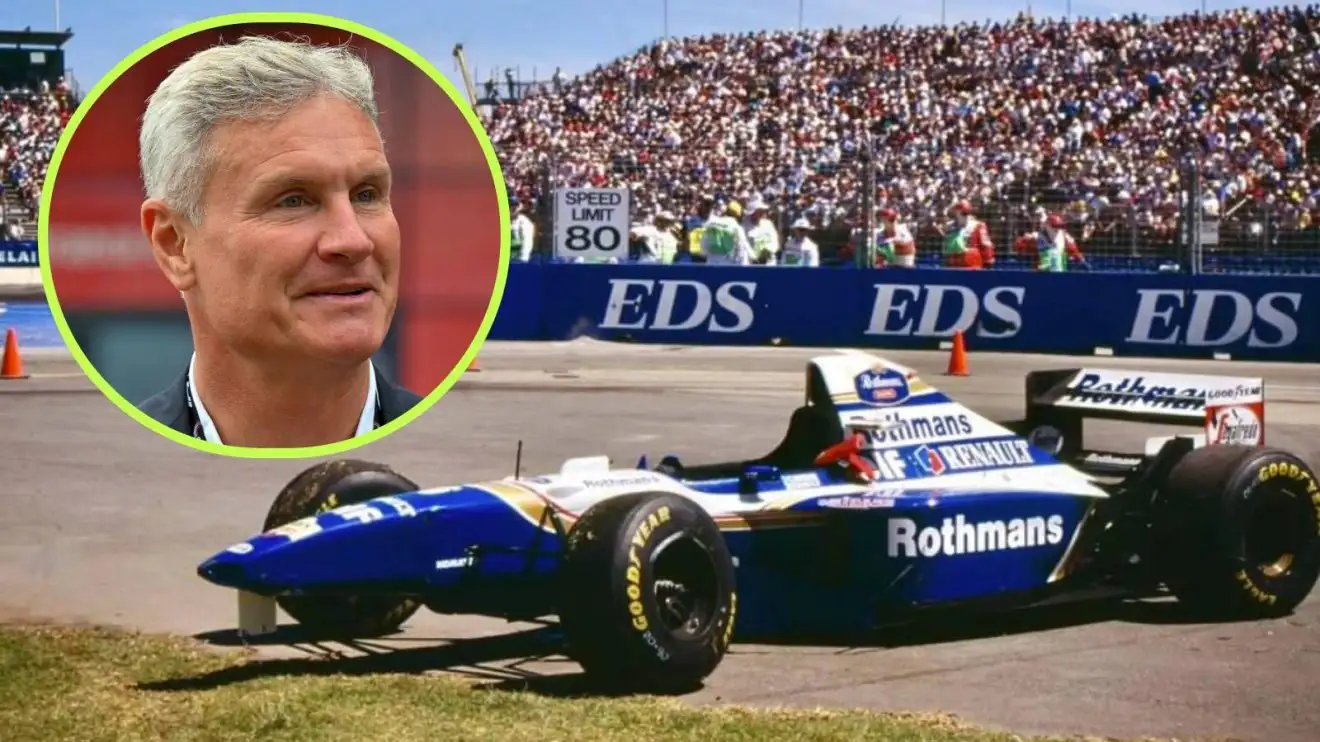Why David Coulthard’s £2.5million crash in 1995 wasn’t entirely his own fault

David Coulthard crashed out of the 1995 Australian Grand Prix.
David Coulthard has revealed how an infamous crash at the end of 1995 ended up costing him around £2.5 million, but it wasn’t entirely his own fault…
Coulthard was leading his final race for Williams when he dived in to make his pitstop in Adelaide, only to lock up and slide straight into the pitlane wall.
David Coulthard: An electronics issue caused my Adelaide crash
Coulthard had qualified second for the 1995 Australian Grand Prix, but beat teammate Damon Hill off the line to take the lead and storm away at the front.
The two Williams drivers were in a league of their own up front and had opened up a lead of almost 20 seconds over third-placed Michael Schumacher when Coulthard made his move to pit on Lap 19.
However, Coulthard appeared to enter the pit lane too fast and locked up, whacking the left-front corner of his Williams against the pitwall and eliminating himself from the race, which Hill went on to win by over two laps over second-placed Olivier Panis.
Externally, at least, it appeared like a straightforward driving error and, while Coulthard is open that he did contribute to the error, the mistake was fundamentally caused by a mechanical malady on his FW17.
“At the end of ’95, at the Adelaide race, I was leading really easily over Damon when I pitted, and shifted down the gears,” Coulthard told PlanetF1.com in an exclusive interview, imitating the engine sounds of the day to illustrate the difference between what should have happened and what actually did.
“When I went to second gear, the autoblip did an overrun, which was not normal, and it pushed the car on. And there was no margin for error whatsoever, and I hit the pit wall.
“It was an electronics issue, followed by a driver error because I didn’t expect the electronics issue. I was cruising.
“With the benefit of experience, you come in a bit slower, just in case. But if you do every corner going ‘just in case’, you don’t do the lap time.
“So yeah, I ended up in the dust. But I ended up in the dust because, when I went to second gear, instead of just gearing down, there was no margin. So silly things like that.”
The crash, Coulthard explained, had far bigger consequences for him than a mere dressing down from Patrick Head and Frank Williams, as he explained how the incident ended up costing him a significant financial windfall.
“If I’d won that race, it would have been half a million pounds bonus,” he said.
“The win bonus was half a million, so I’d won at Estoril and, if I’d won at Adelaide, there’s another half.
“The thing was that if I had won two races in 1995, McLaren would have paid an extra million dollars in each year of my contract for 1996 and ’97. So that one crash cost me two and a half million pounds!”
Coulthard did win his first Grand Prix a few weeks prior to his Adelaide crash, by coming home first in Portugal. Further wins eluded him through mistakes made by inexperience on his part, with ’95 being his first full season in the sport since being parachuted into Ayrton Senna’s car following the death of the Brazilian at Imola in ’94.
“The ’95 car was a great car, I loved that car,” he said.
“But I had a lack of experience, a lack of reliability, a number of factors, and then Michael came through.”
An example of that inexperience came in Japan when a potential podium place went begging.
“One example I remember was at Suzuka, half wet, half dry, getting slightly offline through Spoon and going through the gravel and getting back on track,” he said.
“Then I got to 130R and, because it was slightly damp, instead of being flat, you had to brake.
“Then all the gravel came out of the sidepods, and I ended up spinning on my own gravel. I’d never experienced that in my life before, because I’d never gone into gravel and come out.
“When you did that in testing or something, we only ever had gravel when you’d go offline, and the gravel would come out.
“But, because it was a race, I just gunned it. With the benefit of hindsight, had I pulled over and slowed down like in testing, I would have lost another two seconds on top of whatever it was, yeah, but then I wouldn’t have ended up spinning at 130R. How could I possibly know, until that happened?”
More from the history books:
👉 Inside David Coulthard’s ‘Hollywood’ F1 win: From replacing Senna to Portugal glory
David Coulthard’s contract dispute with Williams
After Adelaide ’95, Coulthard left Williams to join McLaren for 1996, remaining with the Woking-based team until the end of 2004.
It was at Adelaide in ’94 that Coulthard was announced as joining McLaren for ’95, with Williams arguing that Coulthard was on a three-year deal, signed from when Coulthard had begun as a test driver at the start of ’93.
Coulthard’s manager, Mark McCormack, argued the Williams contract wasn’t binding, with the matter going before the FIA’s Contract Recognition Board, which decreed Coulthard was to drive for Williams in ’95, before his ’96 move to McLaren under team boss Ron Dennis.
“That whole contractual dispute came out of the fact that I did the eight races in ’94, and then they obviously had a choice to go with Nigel [Mnasell] or to go with me,” Coulthard remembered.
“They decided to go with me, we agreed on a two-year contract for 1995 and ’96, and we went to sign it on the 28th of December or something like that.
“He’d been having difficulties with Damon, whose manager was going, ‘Hold on, Damon was signed at that level to Ayrton’.
“It’s always about money. I think Frank just got pissed off at the drivers, and although we’d agreed and would get ready to sign a two-year contract, he went, ‘I changed my mind’.
“So the lawyer, Peter Goodman, had to sort of scribble out 1996, and we signed that hand-amended contract for 1995.
“Because we’d been talking to Ron through 1994, he actually wanted us for 1995.
“I was always going to be with Williams for 1995, but I thought it was going to 1996 as well.
“When they changed their mind on doing the two-year contract, we phoned Ron up and went to McLaren to sign for 1996 and ’97.
“So, at the end of ’94, I signed a one-year, hand-amended contract for Williams, and two years then at McLaren.
“Halfway through the ’95 season, Frank was like, ‘Well, I want you guys for next year’.
“I said, ‘I can’t, we signed to McLaren’, and he said, ‘I have a two-year contract with you’.
“I said, ‘As you remember, you changed it to one year’. And then what he tried to imply was the testing contract, which is a kind of rolling contract.
“He tried to get the Contract Recognition Board to enforce the testing contract. Of course, the CRB said, ‘Well, that’s been superseded by the new race contract from 1995 (the one with 1996 scribbled out), which the CRB had, and they went to them to say, ‘You don’t have this multi-year testing contract’.
“So that then meant that the last half year with Williams, Patrick [Head] was a bit upset about it, but he just didn’t understand what had happened in 1994.
“If Frank had just honoured, and this is not beating on him, what we’d negotiated, I would have spent 1995 and ’96 and probably beyond, and McLaren would have found another situation.
“So it kind of tainted the end of my Williams relationship. But Frank was always a gentleman about it, even after coming out of the CRB, he went, ‘I thoroughly enjoyed being cross-examined’.
“Then I got on his plane to the next Grand Prix! Frank was able to have an argument in a very polite way and then move on, whereas some people hold a grudge forever. I have nothing but respect for Frank and the Williams team, who started my career.
“He certainly gave a lot of young drivers, which meant cheap drivers, opportunities. But, when he needed to invest – when he could get Ayrton, he got Ayrton.
“So I think probably losing Nigel [Mansell]… he left haggling money, but it was Frank’s own money he was spending.
“So, unlike Ron, or someone where half of the salary was paid by Marlboro and the other half was paid by the engine partner… effectively, Mika [Hakkinen] and I were paid by Mercedes and Marlboro [at McLaren]. Of course, if the money’s going to us, it’s not going to the team.
“But, in terms of Ron, he had his team budget, and out of that team budget, he did not have to pay the drivers. But, for Frank, I suspect he was paying the drivers a lot. That’s money that he then couldn’t spend on engineering.
“I have nothing but respect for the opportunity that was presented to me by Williams and then McLaren. McLaren had a very different face and feel, but it worked for me, and I spent nine seasons there – a long time with one team!”
Read Next: Aston Martin issues statement as Yuki Tsunoda rumours enter overdrive





